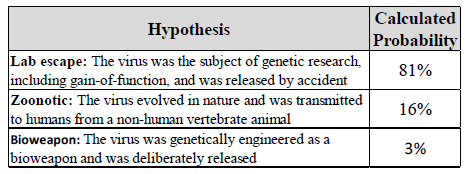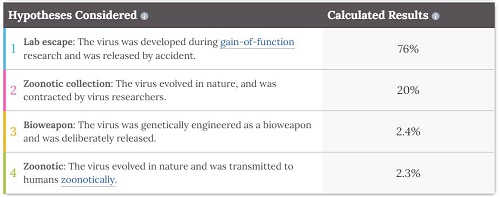|
TRANSLATE THIS ARTICLE
Integral World: Exploring Theories of Everything
An independent forum for a critical discussion of the integral philosophy of Ken Wilber
  Frank Visser, graduated as a psychologist of culture and religion, founded IntegralWorld in 1997. He worked as production manager for various publishing houses and as service manager for various internet companies and lives in Amsterdam. Books: Ken Wilber: Thought as Passion (SUNY, 2003), and The Corona Conspiracy: Combatting Disinformation about the Coronavirus (Kindle, 2020). Frank Visser, graduated as a psychologist of culture and religion, founded IntegralWorld in 1997. He worked as production manager for various publishing houses and as service manager for various internet companies and lives in Amsterdam. Books: Ken Wilber: Thought as Passion (SUNY, 2003), and The Corona Conspiracy: Combatting Disinformation about the Coronavirus (Kindle, 2020). TABLE OF CONTENTS | REVIEWS
Was the SARS-Cov-2 virus created in the Wuhan lab?The Corona Conspiracy, Part 17Frank Visser
ALTERNATIVE VIRAL FACTS
Arguing for a purely natural origin of the virus doesn't make one a China puppet, nor is advocating the lab leak theory necessarily the result of a mindset colored by conspiracy.
In the past episodes of this Corona Conspiracy series, we have dealt with virus denialists, who deny the very existence of the SARS-Cov-2 virus (or even of all possible viruses). But this relates only to the first of fifteen items that compose the standard scientific view of this pandemic that can be denied. Apart from its existence, there is legitimate debate about its contagiousness and its harmfulness. This is an area of epidemiology and statistics I don't won't to go into here, because this is the domain of regular science. Even within that domain, intense disagreement can occur about the scope of the problems we are facing. True, some claim the impact of the pandemic is overestimated or exaggerated by some groups in society, with ulterior motives. Three other items on this list (6, 7, 8) have become highly relevant in the past week, due to a whistleblower from Hong Kong, who fled to the US to tell the world about the true source of this virus. Does the virus have a natural origin? Or has it been spread on purpose, as a bio-weapon? Or was it perhaps spread accidentally, by a lab accident? We will go into this explosive material in the current essay.
Meet Whistleblower Li-Meng Yan Li-Meng Yan Li-Meng Yan, a Chinese virologist working at the Hong Kong School of Public Health, fled to the US in July 2020 and published a 26-page pre-print research paper with the breath-taking title "Unusual Features of the SARS-Cov-2 Genome Suggesting Sophisticated Laboratory Modification Rather Than Natural Evolution and Delineation of Its Probable Synthetic Route".[1] It claimed that the SARS-Cov-2 virus was made in a Chinese government or military laboratory and even provided an example of how this could have been done in a matter of months. She announced the article on a new Twitter account, and collected 60.000 followers in a few days—until Twitter banned her account for violating its "policies". She seems to be back with a new Twitter account (@DrLiMengYAN1). The authors of the paper belong to a Rule of Law Society & Rule of Law Foundation, an organization founded by Steve Bannon, former chairman of Breitbart News and chief strategist to Donald Trump, and Chinese billionaire Guo Wengui, who fled to the US in late 2014. The RLS has as its mission "To permit the people of China to live under a national system based on the rule of law, independent of the political system of the People's Republic of China ("China")." Bannon was recently arrested on the yacht of Guo Wengui for fraudulent dealing with contributions to the Build the Wall campaign. So the geopolitics is clear: an anti-China organization sponsors a semi-scientific article accusing the Chinese government of spreading a harmful virus. Of course, such a message lands well in right-wing America, so Li-Meng Yan did the rounds on the conservative media circuit. Among other media, she was interviewed for Fox News by Tucker Carlson. Here you can see that episode for yourself:
Coronavirus whistleblower speaks out about possible COVID origin on 'Tucker'
From this video I gather that the message she wants to tell the world is that SARS-Cov-2 is a very dangerous virus, and that it was created in a Chinese lab. I wonder how this message lands in the Trumpian universe, which has always dismissed the pandemic as not very serious. But for sure Donald Trump would love to hear from her that it is a "Chinese virus" after all! We will not touch on the highly charged political aspects of this matter, but focus on the scientific side, which is already maddeningly complex for laymen. At the moment it is fair to say that arguing for a purely natural origin of the virus doesn't make one a China puppet, nor is advocating the lab leak theory necessarily the result of a mindset colored by conspiracy. The theory should be evaluated according to its own scientific merits. And no, being in the company of Bannon and Wengui definitely isn't ideal to get a hearing from the scientific community at large. But then again, where else would a whistleblower with such an explosive message find shelter in times of a worldwide crisis? Is it plausible to claim the SARS-Cov-2 virus has been manufactured in a lab? Was it perhaps only a natural virus studied and stored in a lab and did it escape accidentally? Was it the product of so-called "gain-of-function" research, which is done all over the world in various labs? Was an existing virus tweaked to make it more harmful? Is it likely it escaped from the Wuhan lab, which exists in the close proximity of the Wuhan wetmarket? If it really is a bio-weapon, why is it not more harmful? These are all at least theoretical, if rather speculative, possibilities. Reading the virus genome feels like reading tea leaves to me. Is there evidence that the genome of SARS-Cov-2 has traces of manipulation, or is it anybody's guess? Making Sense of ‘The Yan Report’ The "Yan Report", as the paper download file is named by the authors, has had (as of today, September 21) 698,879 views and 539,705 downloads in only one week time—and counting—, which is an incredible accomplishment. Talking about "going viral"! This is the central claim by the authors of this paper: Despite its tremendous impact, the origin of SARS-CoV-2 has remained mysterious and controversial. The natural origin theory, although widely accepted, lacks substantial support. The alternative theory that the virus may have come from a research laboratory is, however, strictly censored on peer-reviewed scientific journals. Nonetheless, SARS-CoV-2 shows biological characteristics that are inconsistent with a naturally occurring, zoonotic virus. In this report, we describe the genomic, structural, medical, and literature evidence, which, when considered together, strongly contradicts the natural origin theory. (Abstract, p. 1) To make a long story short, here are the three claims presented in the "Yan Report": We present three lines of evidence to support our contention that laboratory manipulation is part of the history of SARS-Cov-2: To make sense of this technical language, it is perhaps best to read an early article, published in mid-March on the "Nerd has Power" blog, called "Scientific evidence and logic behind the claim that the Wuhan coronavirus is man-made", together with its companion article ""RaTG13 - the undeniable evidence that the Wuhan coronavirus is man-made".[2] The author is anonymous, for reasons I don't follow, and describes himself as "A nobody scientist." At least the Yan report has identifiable names as authors. Obviously, this is not the way to get a hearing from science. Truth be told, Kevin McCairn and Richard Fleming, who supported me in debunking Andrew Kaufman's virus-equals-exosome theory, also subscribe to this theory that the virus is (at least in part) likely man-made by gain of function research and possibly escaped from a lab. So I am in for some cognitive dissonance here. The upshot of the paper is that the authors claim that the SARS-Cov-2 virus genome is "suspiciously similar" to another virus, shows "suspicious resemblance" to the earlier SARS-CoV virus (but weren't they family members?), and has a few extra inserts, presumably added to an existing viral "backbone" genome, that enhance its infectivity. Most probably this was done to be able to use it as a bio-weapon. The ‘suspicious’ PRRA insertZooming in on the third point, the extra inserts of a few amino acids, it is interesting to see how this rumor was already around very early on in the pandemic.[3] Bill Gallaher, Emeritus Professor Department of Microbiology, Immunology & Parasitology, states in his blog post "Tackling Rumors of a Suspicious Origin of nCoV2019" (as early as Feb. 7, 2020!): I have been privately dealing with rumors and inquiries, focused on the RRAR potential furin cleavage site, that nCoV2019 may have a suspicious origin as an engineered, laboratory-generated virus either accidentally or deliberately released in the area of the Wuhan seafood and animal market. The publication of the highly similar RaTG13 sequence about a week ago has fueled this type of speculation.[3] The scientific consensus is that SARS-CoV-2 was derived from a common ancestor of a bat corona virus, represented by the strain RaTG13, which was isolated in Yunnan province in 2013. Please note this is not the thesis of the authors of the Yan Report; they consider the genome of RaTG13 even to be "suspicious", "fabricated" and even "likely fraudulent". I am just giving it as an example of how tricky it can be to draw conclusions from virus genome comparisons.
The PRRA insert in the "Wuhan" genome, compared to the RaTG13 virus genome.
"Wuhan" is the SARS-Cov-2 virus, "RaTG13" is a supposedly very similar one (except for the inserts). All amino acids match perfectly, except in four places. Slightly enlarged for better readability:  The letters "PRRA" stand for four amino acids: "Pro, Arg, Arg, Ala", or "Proline, Arginine, Arginine, Alanine". If you remember from your school days, each amino acid is coded by three bases (called "codons"). But there is some flexibility here: one amino acid can be coded by several different codons. For example: Arginine can be coded by CGU, CGC, CGA, CGG, AGA, and AGG. They are all "synonyms" for Arginine. (So synonymous base changes won't make a difference. It is the non-synonymous base changes theses researchers are looking for, because they change the functionality of the genome.) Now this specific amino acid sequence PRRA translates in this genome to the following base sequence: CCT CGG CGG GCA. 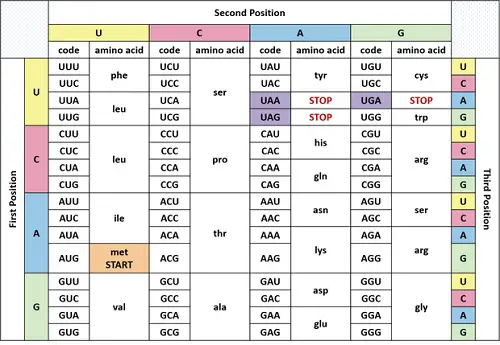
Source: "Why a Triplet Code?", The Plant and Soil Sciences eLibrary
It needs a professional virologist to unpack that code for us now: CCT CGG CGG GCA. Note that Gallaher mentions both PRRA and RRAR in his blog post, so I give the full range here:
Gallaher continues and warns about being misled by superficial similarities between amino acid sequences in viral RNA genomes.[3] They can hide multiple differences that happen at the base level, and these are the real indicators of similarity (and a possible evolutionary relationship) between viruses: 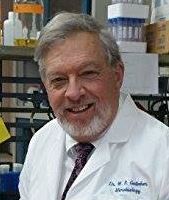 Bill Gallaher One has to consider that the PRRA is an unusual sequence to introduce to generate a furin site — others even among coronaviruses like MHV A59 are so much better. Also that the underlying code CCTCGGCGGGCA introduces an unnecessarily G and C rich region where none otherwise exists. Not likely scenarios for something a gene jockey would do. Then one looks at the actual RNA alignment. The “insert” is actually not in frame, but CTCCTCGGCGGG, or -2 out of frame. Again, who does that? As you can see in the above table, the insert is offset to the left by two bases. But now the trick: it is placed right in the middle of a codon, so that this is cancelled out. The PRRA sequence is added and the rest of the genome is still readable. That's basically because the lenght of the insert can be divided by 3, so the codon structure is preserved. But the PROOF lies in looking at the 288 alignable nucleotides on either side of the “insert”. While they cover identical protein sequence, the RNA is not at all identical, but 6.6% different — 19 mutations out of 288. All 19 are mutations in the wobble base of their respective codons. There are so many that the frame can be inferred from the 2/1 pattern even without knowing the beginning or the end, or indeed that the encoded protein sequence is identical — those are self-evident by looking at the RNA itself. 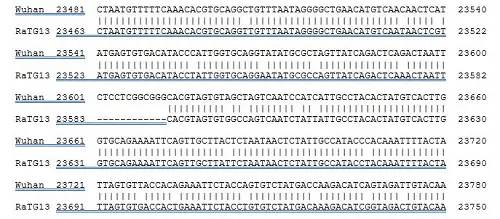 We know from influenza H1N1, for which we have serial isolates from 1918 to the present, that wobble base mutagenesis occurs at a rate of 0.95% per decade. This permits an estimation of the TMRCA of the two sequences nCoV2019 and RaTG13 of 69.5 years ago — roughly 1950 +/- 10 years or so. RaTG13, or anything nearly identical to it at the RNA level, simply could not be a proximal source of nCoV2019. It just LOOKS like it might be…at first glance. Given that furin cleavage signals are present in other coronaviruses at exactly that point in the S1/S2 boundary region, it only LOOKS unusual, especially against the backdrop of SARS. The preponderance of evidence, coupled with Ockham's razor (that the simplest explanation is preferred) dictates that the PRRA sequence has been conserved in nCoV2019 from a long ago ancestor virus. It is not of suspicious origin. The closest bat virus sequence is really not close at all. RNA don't lie. Prof. Gallaher's follow up comments to his original blog post are tantalizing, and point in the direction of a fully natural origin of SARS-CoV-2. "I have found a probable source of the putative insert that adds the RRAR furin site to SARS-CoV-2. Ten of the 12 nucleotides in the RRAR insert are identical to a sequence in the spike protein gene of Bat Coronavirus HKU9 isolated from a Rousettus fruit bat in Guangdong province in 2011." And: "So the definitive source of the pandemic is a mixed infection of viruses similar to SARS-CoV-2 and Bat HKU9 — copy choice error resulting in an insert in SARS-CoV-2. Could occur in bats, intermediate animal or human." (May 2, 2020). He concludes: This accidental mixed infection in the wild, and infection of a human by some form of bush meat or bat guano, who carries it by high speed train to Wuhan — this is the most likely series of events leading to the pandemic. I won't torture you with more technical details. The reason I am relating this is that even experienced virologists can differ widely in their interpretation of genome sequences. At the very end of the Yan Report the authors point to the insert PRRA as well. They too notice it has a very uncommon coding CGG CGG, and they suspect this has been introduced as a marker:  And they conclude: "In fact, this CGGCGG arrangement is the only instance found in the SARS-CoV-2 genome where this rare codon is used in tandem. This observation strongly suggests that this furin-cleavage site should be a result of genetic engineering." (p. 13) (underlining in the article) Gallaher has summarized his views in a recent paper "A Palindromic RNA Sequence as Common Breakpoint Contributor to Copy-choice Recombination in SARS-CoV-2", which explains how recombination events in viral genomes can result in "suspicious inserts" for fully natural reasons.[4] So this same small and strange snippet of code in the SARS-CoV-2 genome PRRA is taken by Gallager as evidence for a natural origin ("not likely a gene jockey would do"), whereas lab origin theorists such as Li-Meng Yan et al. come to the exact opposite conclusion: it must therefore have been added by gain of function research. I must confess my lack of expertise to answer these questions, so let us move on. Mainstream peer reviewsHow did mainstream virologists respond to the Yan Report? Predictably, very dismissive.[5] Here's an anthology: According to the paper's abstract, "SARS-Cov-2 shows biological characteristics that are inconsistent with a naturally occurring, zoonotic virus" and that it could have been created in a lab in approximately six months. According to Newsweek, several experts in evolutionary biology and infectious disease, including Jonathan Eisen and Carl Bergstrom, said the paper did not include new information, contained multiple unsubstantiated claims and had a weak scientific case. Angela Rasmussen, a virologist at Columbia University, said the paper was "basically all circumstantial and some of it is entirely fictional". For example the paper asserts that SARS-Cov-2 has a "unique" furin cleavage site in its protein structure "completely absent in this particular class of coronaviruses found in nature"; however Rasmussen says that many coronaviruses, including the 2012 MERS coronavirus, have these sites and that hence "This proves exactly nothing." Yan's paper also stated that two strains of bat coronaviruses discovered in China, ZC45 and ZXC21, were "suspiciously" similar to SARS-Cov-2 and these strains could have been used as a template for a deadlier virus. The two strains differed by approximately 3,500 nucleotide base pairs. Several virologists, including Rasmussen, said it would be either inefficient or impossible to engineer a virus where 10% of its genome would have to be replaced. In addition to citing many other unpublished pre-print papers, Yan's September 2020 pre-print cited online blogs and obscure web sites named "GM Watch" and "Nerd Has Power". Immunologist Kristian G. Andersen, a specialist in communicable diseases and genomics who was one author of a March 2020 journal article in Nature Medicine entitled "The proximal origin of SARS-Cov-2"[6] which definitively stated the virus was not created in a lab, and Yujia Alina Chan, a postdoctoral researcher, both said the paper left out recent data related to coronavirus in pangolins and bats. Andersen further characterized the paper's prose with the statement: "It's using technical language that is impossible to decode for non-experts—poppycock dressed up as 'science'." (Wikipedia)
Whatever the outcome, let's rely on solid and expert science, that is validated in the scientific community, instead of giving in to the temptation of conspiracy theories, which thrive only in obscure online subcultures.
‘a comprehensive investigation’So where do we go from here? The question as to the true origin of SARS-Cov-2 remains legitimate and is currently the subject of research (though the Chinese government might not be too cooperative). Last week The Telegraph reported[7]: An international team of scientists will examine the possibility SARS-Cov-2 leaked from a laboratory as part of a comprehensive investigation into the origins of the virus. The leader of this project is Peter Daszak, a British zoologist and leading authority on zoonotic "spillover" events. This will not land well with the "lab origin" folks, I guess, but Daszak replies to them as follows: 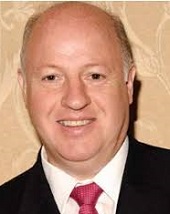 Peter Daszak Dr Daszak said yesterday he and his team would “systematically examine every theory” about the origin of the virus, carefully marshalling the scientific evidence for each. He accepted conspiracy theorists would not welcome his appointment but said, as a scientist, he would “not be bound by preconceived ideas” and would investigate all avenues forensically and “with an open mind”. He warned, however, it was not possible to “prove a negative” and said it was unlikely it would ever be possible to say with “absolute certainty” how the virus emerged. The choice of Peter Daszak to lead this investigation has generated quite some scepticism and even outrage[8], given his involvement with the Wuhan Intitute of Virology (WIV), even with gain of function research, but also from scientists like Kristian G. Andersen, author of the Nature paper defending the natural origin theory[6], who tweeted in response: "Not the right person for the job... That's ridiculous."
Whatever the outcome, let's rely on solid and expert science, that is validated in the scientific community, instead of giving in to the temptation of conspiracy theories, which thrive only in obscure online subcultures. As virologist Ian MacKay remarked to me on Twitter, these are all cases of "a little knowledge [is a dangerous thing]." CONCLUSIVE EVIDENCE FOR A NATURAL ORIGIN?As Gallaher already demonstrated, with all the focus on "suspicious inserts", it really pays to give attention to the "non-suspicious" parts of the viral genomes. Dan Wilson, a PhD scientist in molecular and structural biology, has a YouTube channel "Debunk the Funk with Dr. Wilson", on which I found this debunk of the Li-Meng Yan et al. paper. He has also debunked Kaufman, Cowan, the Chromosome 8 canard, Michael Yeadon, PCR Gate, and many other topics covered in this THE CORONA CONSPIRACY series, so he's definitely a kindred spirit. Here's a nice short video defending the natural origin viewpoint:
Dan Wilson, "No, the coronavirus still was NOT made in a lab", 29 Sept 2020.
From which: To be honest, I don't care if this report [by Li-Meng Yan] was written by Albert Einstein himself or Bozo the Clown. I'm just going to look at the evidence and judge it for its scientific merit. Although this report looks really sciency with lots of references and lots of figures, to the trained eye it is complete garbage and in this video I'm going to walk you through exactly how to tell for yourself that it's garbage, so that you can think for yourself and not fall for this misinformation in the future. (0:52-1:18)
Wilson makes the valid point that if the virus was manipulated in a lab, one would expect a perfect match with the original "backbone" virus, and some adjustments made by the researcher. In fact, what we find when aligning these four viruses is that, aside from the "suspicious insert", many more differences show up throughout the genomes. Hence, says Wilson, this is proof that the SARS-CoV-2 virus is not artificially made, but shows all the signs of a natural evolution. Four viruses are crucial in Li-Meng Yan's story, so he pulled up the official genome sequences of all four:
Here's an example of a small fragment of such an alignment, which includes our mysterious insert: CCT CGG CGG GCA.
 As you can see most mutations happen in the 3rd codon, for example when GCA becomes GCT. There are eight in a row in this example. This is a called "synonymous" mutation, for the 3rd codon doesn't really matter for encoding the aminoacid. When mutations happen in the first two codons, a change in aminoacid occurs, and most of these mutations don't work. These are called "non-synonymous". However, some of these non-synonymous mutations lead to improvements. Take any other fragment of this alignment and you will see these mutations throughout the genomes (whenever the * denoting a perfect match is missing).  Even when SARS-CoV-2 is aligned with one of the "backbone" viruses, quite some differences show up. : 
Genome alignment of 4 related viruses shows multiple mutations (MUSCLE).
All this points to a natural evolution of these viruses. Superficial similarity can hide deeper differences. To repeat from Wikipedia: "Several virologists, including Rasmussen, said it would be either inefficient or impossible to engineer a virus where 10% of its genome would have to be replaced." OVERVIEW OF THE AVAILABLE HYPOTHESESThe bio-weapon option is not taken seriously by the regular media and scientists, since the whole subject has been heavily politicized. It is uniquely argued for by Li-Meng Yang and her team, and several independent online researchers. In the recently completed Joint Report[9] by the WHO team that investigated the origin of SARS-CoV-2, four hypothesis are mentioned, ranked in order of likelihood:[10]
I have added the bio-weapon hypothesis in the below diagram for completeness, and some really outlandish panspermia hypothesis claiming the virus came from outer space (seriously):[11] 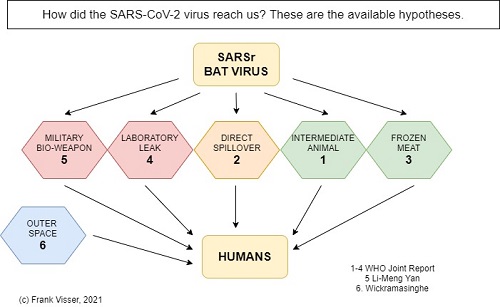
The available hypotheses about the origin of the SARS-CoV-2 virus.
A final note on the bio-weapon hypothesis advanced by Li-Meng Yan. As I described in earlier chapters, conspiracy theory usually implies the virus is less harmful, or even healthy or non-existent. But in this particular case, the harmfulness of the virus is emphasized. Where science discovers more and more organs that can be damaged by this virus, the bio-weapon hypothesis holds that this functionality is there by design. Appendix 1: Pre-Print Peer Reviews
Appendix 2: Follow Up PAPERS BY LI-MENG YAN ET AL.
Appendix 3: Follow Up PAPERS ON NATURAL ORIGIN
Proponents of theories for the unnatural origin of severe acute respiratory syndrome coronavirirus-2 (SARS-CoV-2) have asserted that the 12 nucleotide insert in the spike gene, which results in acquisition of a furin cleavage site in spike, may have arisen by laboratory manipulation (Relman, 2020; Segreto and Deigin, 2020; Seyran et al., 2020; Sirotkin and Sirotkin, 2020). Here, we compile evidence demonstrating that insertion/deletion (indel) events at the S1/S2 and S2’ protease cleavage sites of the spike precursors are commonly occurring natural features of coronavirus evolution. We also identify heretofore undescribed similarities in the S1/S2 and S2’ cleavage sites of multiple diverse coronavirus spikes that provide further evidence against a laboratory origin of SARS-CoV-2. (empasis added) (Garry & Gallaher)
Appendix 4: ON THE NATURAL VS. LAB ORGIN QUESTION
Appendix 5: A BIO-WEAPON? WEIGHING THE ODDS
Interesting to see that these two "Bayesian" analyses give 2-3% credence to the bio-weapon hypothesis but deem a lab escape very likely (76-81%). Of course, this could be a case of false accuracy, for these conclusions are only as solid as the various estimates they are based on, but at least they suggest a structured and systematic approach to the problem of the origin of SARS-CoV-2. NOTES[1] Yan, Li-Meng; Kang, Shu; Guan, Jie; Hu, Shanchang, "Unusual Features of the SARS-Cov-2 Genome Suggesting Sophisticated Laboratory Modification Rather Than Natural Evolution and Delineation of Its Probable Synthetic Route", zenodo.org, September 14, 2020 [2] Anonymous, "Scientific evidence and logic behind the claim that the Wuhan coronavirus is man-made", nerdhaspower.weebly.com, 15 mrt. 2020. See also on the same blog: Anonymous, "RaTG13 - the undeniable evidence that the Wuhan coronavirus is man-made", nerdhaspower.weebly.com, no date, which is cross posted on https://gnews.org/192144/, May 2, 2020. Gnews.org is owned by Guo Wenghui. [3] Bill Gallaher, "Tackling Rumors of a Suspicious Origin of nCoV2019", virological.org, February 7, 2020. See also his free ebook "Analysis of Wuhan Coronavirus - Deja Vu", February 2020. [4] Gallaher, W.R. A palindromic RNA sequence as a common breakpoint contributor to copy-choice recombination in SARS-COV-2. Arch Virol 165, 2341-2348 (2020). https://doi.org/10.1007/s00705-020-04750-z. [5] Monique Brouillette & Rebecca Renner, "Why misinformation about COVID-19's origins keeps going viral", www.nationalgeographic.com, Sep. 18, 2020. [6] Kristian G. Andersen, Andrew Rambaut, W. Ian Lipkin, Edward C. Holmes & Robert F. Garry, "The proximal origin of SARS-Cov-2", www.nature.com, 17 March 2020. [7] Paul Nuki, "Scientists to examine possibility Covid leaked from lab as part of investigation into virus origins", www.telegraph.co.uk, 15 September 2020. [8] Anonymous, "Scientists outraged by Peter Daszak leading enquiry into possible Covid lab leak", www.gmwatch.org, 23 September 2020. [9] The full WHO report can be found here: "WHO-convened Global Study of the Origins of SARS-CoV-2", WHO, 30 March 2021. [10] Kai Kupferschmidt, "'Compromise' WHO report resolves little on pandemic's origins, but details probe's next steps", sciencemag.com, Mar. 30, 2021. [11] Edward J. Steele et al., "Origin of new emergent Coronavirus and Candida fungal diseases—Terrestrial or cosmic?", Adv Genet. 2020; 106: 75-100. July 2020. 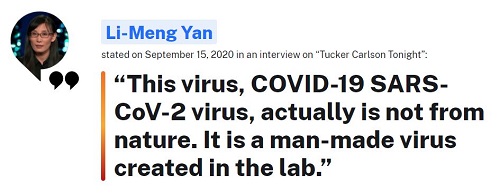
"Tucker Carlson guest airs debunked conspiracy theory that COVID-19 was created in a lab" (Politfact)
83 Vaccine Myths from docbastard.net
To all those who claim SARS-CoV-2—or any virus—does not exist: the virosphere consists of 7 realms
11 kingdoms, 22 phyla, 4 subphyla, 49 classes, 93 orders, 12 suborders, 368 families, 213 subfamilies, 3,769 genera, 86 subgenera, 16,215 species. Take that.
https://talk.ictvonline.org/taxonomy/
A summary of early parts of this series has appeared in the Dutch magazine Skepter 33(3), September 2020, as "Viruses don't exist" (covering Parts 1-5). German: Skeptiker (December 2020); English: Skeptic.org.uk (January 2021)
Comment Form is loading comments...
| ||||||||||||||||||||||||||||||||||||||||||||||||||||||||||||||||||||||||
